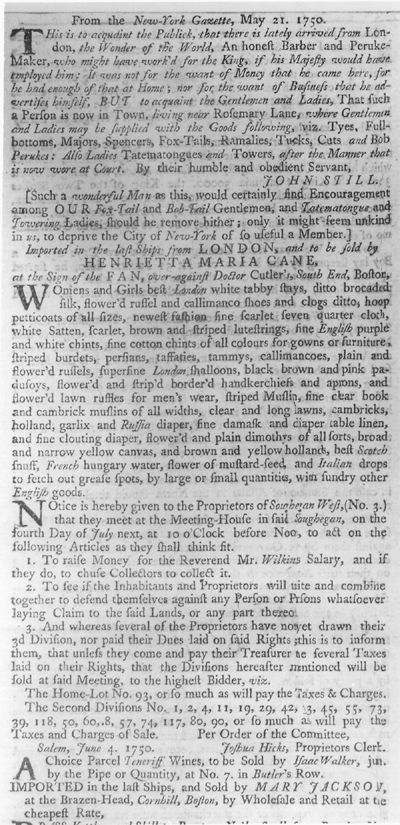
|
|
Henrietta Maria East Caine, 1750 Advertisment Like Elizabeth Murray, Henrietta Maria East settled in Boston with the intention of becoming a shopkeeper. Arriving from London in 1743 with a stock of goods, she opened a millinery shop, where she sold the kinds of fashionable items increasingly in demand in teh colonies. In 1747, Henrietta Maria East made a fateful decision when she married Hugh Caine, a man who turned out to have a wife already in London. In 1751, Hugh deserted Henrietta and absconded with her property, after four years of what she characterized as a marriage marked by his violence toward her. Unfortunately, Hugh Caine's departure did not end the problems caused by the marriage. Henrietta Maria East Caine remained legally obligated for all of his debts and found merchants unwilling to trade with her because of her connection to the absent bigamist. The legal coverture that women experienced with marriage limited her ability to act independently. Eventually, she turned to the courts to dissolve her marriage, but without success. A regular advertiser, Henrietta was one of only three women to place notices for their shops in the pages of the Boston Evening-Post in the summer of 1750. The other two were Mary Jackson and Elizabeth Murray. For more on Henrietta Maria East Caine's life and career, see Patricia Cleary, Elizabeth Murray: A Woman's Pursuit of Independence in Eighteenth-Century America (Amherst: University of Massachusetts Press, 2000), 45-46, 57, 60, 62-63, 241n. |
||
Mary Jackson's advertisement, 1750 |
|||
 Henrietta Maria East Caine, Boston Evening-Post, 11 June 1750, Courtesy, American Antiquarian Society
Henrietta Maria East Caine, Boston Evening-Post, 11 June 1750, Courtesy, American Antiquarian Society 

